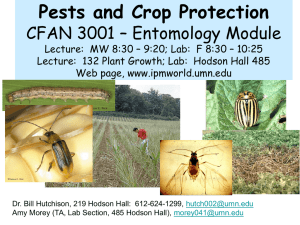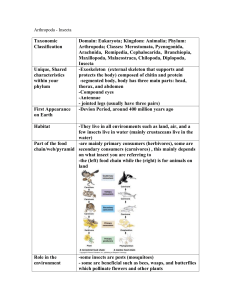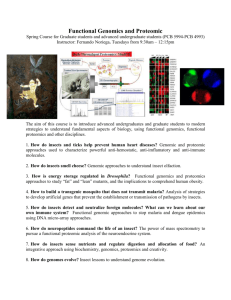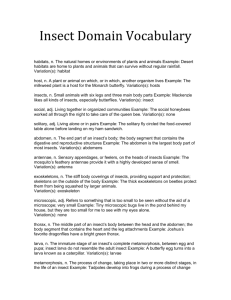Insect Taxonomy - Faculty of Agriculture
advertisement
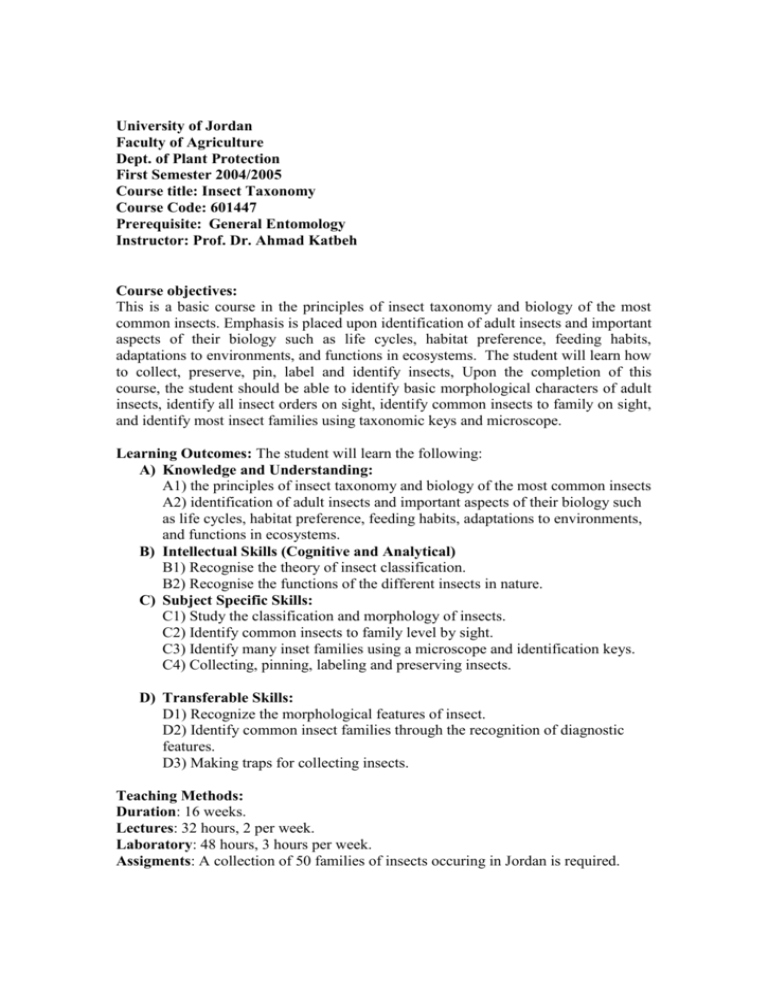
University of Jordan Faculty of Agriculture Dept. of Plant Protection First Semester 2004/2005 Course title: Insect Taxonomy Course Code: 601447 Prerequisite: General Entomology Instructor: Prof. Dr. Ahmad Katbeh Course objectives: This is a basic course in the principles of insect taxonomy and biology of the most common insects. Emphasis is placed upon identification of adult insects and important aspects of their biology such as life cycles, habitat preference, feeding habits, adaptations to environments, and functions in ecosystems. The student will learn how to collect, preserve, pin, label and identify insects, Upon the completion of this course, the student should be able to identify basic morphological characters of adult insects, identify all insect orders on sight, identify common insects to family on sight, and identify most insect families using taxonomic keys and microscope. Learning Outcomes: The student will learn the following: A) Knowledge and Understanding: A1) the principles of insect taxonomy and biology of the most common insects A2) identification of adult insects and important aspects of their biology such as life cycles, habitat preference, feeding habits, adaptations to environments, and functions in ecosystems. B) Intellectual Skills (Cognitive and Analytical) B1) Recognise the theory of insect classification. B2) Recognise the functions of the different insects in nature. C) Subject Specific Skills: C1) Study the classification and morphology of insects. C2) Identify common insects to family level by sight. C3) Identify many inset families using a microscope and identification keys. C4) Collecting, pinning, labeling and preserving insects. D) Transferable Skills: D1) Recognize the morphological features of insect. D2) Identify common insect families through the recognition of diagnostic features. D3) Making traps for collecting insects. Teaching Methods: Duration: 16 weeks. Lectures: 32 hours, 2 per week. Laboratory: 48 hours, 3 hours per week. Assigments: A collection of 50 families of insects occuring in Jordan is required. Method Objective: Learning outcomes Assessments Teaching Methods Lectures Laboratory A1-A2, B1-B2, C1-4, D1-2 Written Exams Practical Exams Field Study D3 Reports and Assignments Exams & Evaluation: 1) First Exams (15 points) 2) Second Exam (15 points) 3) First Lab. Exam (5 points) 4) Final Lab. Exam (10 points) 5) Insect Collection and Report (15 points) 6) Final Exam ( 40 points) Course Contents Introduction to the world of insects Introduction to Insect Taxonomy, History of systematics, definitions Modes of speciation, taxonomic procedures, taxonomic publications, international code of zoological nomenclature, zoogeographic regions of the world. Classification of the Hexapoda, insect orders and families of. Protura, Collembola, Diplura, Microcoryphia, Thysanura. Ephemeroptera, Odonata, Grylloblattarla, Phasmida Orthoptera, Mantodea, Mantophasmatodea, Blattaria, Isoptera, Dermaptera, Embiidina, Plecoptera, Zoraptera, Psocoptera Phthiraptera, Hemiptera Homoptera, Thysanura, Neuroptera Coleoptera Strepsiptra, Mechoptera, Siphonaptera Diptera Trichoptera, Lepidoptera Hymenoptera, revision 2hour 4hours 2 hours 2 hours 2 hours 2 hours 2 hours 2 hours 2 hours 4 hours 2 hours 2 hours 2 hours 2 hours Text Book Borror. D. J. C. A. Triplehorn, and N. F. Johnson. 1989. An Introduction to the Study of Insects. 6h Edition. Philadelphia. PA. Saunders Publishing Company. 875 PP. References: Bland. R. G. and H. E. Jaques. 1984. How to know the Insect. The pictured key nature series. Wm. C. Brown Company publishers. Dubuque, Iowa. 409 pp. Dashefsky. H. S. and J. G. Stoffoland. A Tutorial Guide to the Insect Orders (.Adults). Burgess Publishing Company, Minneapolis, Minnesota, 57 PP. Mayr. E. and Ashlock, P. 1991. Principles of Systematic Zoology. Second Edition. McGraw-Hill, INC USA. 475 PP. Ride. W. D. et al (editors). 1985. International code of Zoological Nomenclature. University of California Press. Third Edition. 338 PP. Papers in in several entomology journals. Important Regulations: The student is required to present a collection (due one week before the final exam) of 50 insect families. Each insect should be pinned or preserved in alcohol or in a slide. It should be labeled with location, date, host, collecter's name, and identification. The label should be printed on lazer printer or written with Indian ink. The collection should be organized in a box according to insect's orders. It should be presented with a report showing number of specimens, a list of orders, families, and identified species. Grading will depend on quality, quantity, organization and identification of the specimens. No sharing of specimens is allowed except for specimens collected in field trips conducted together.





